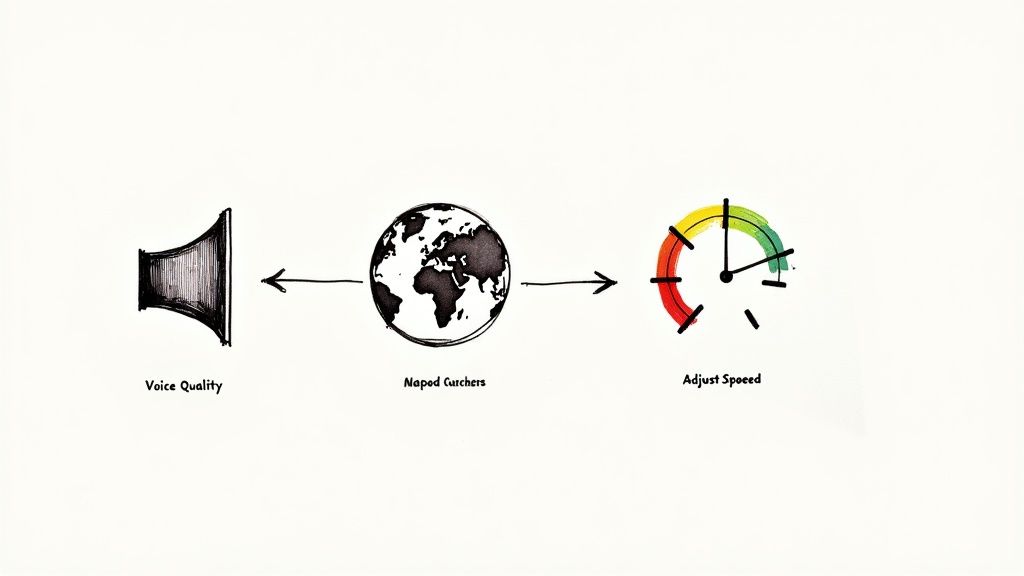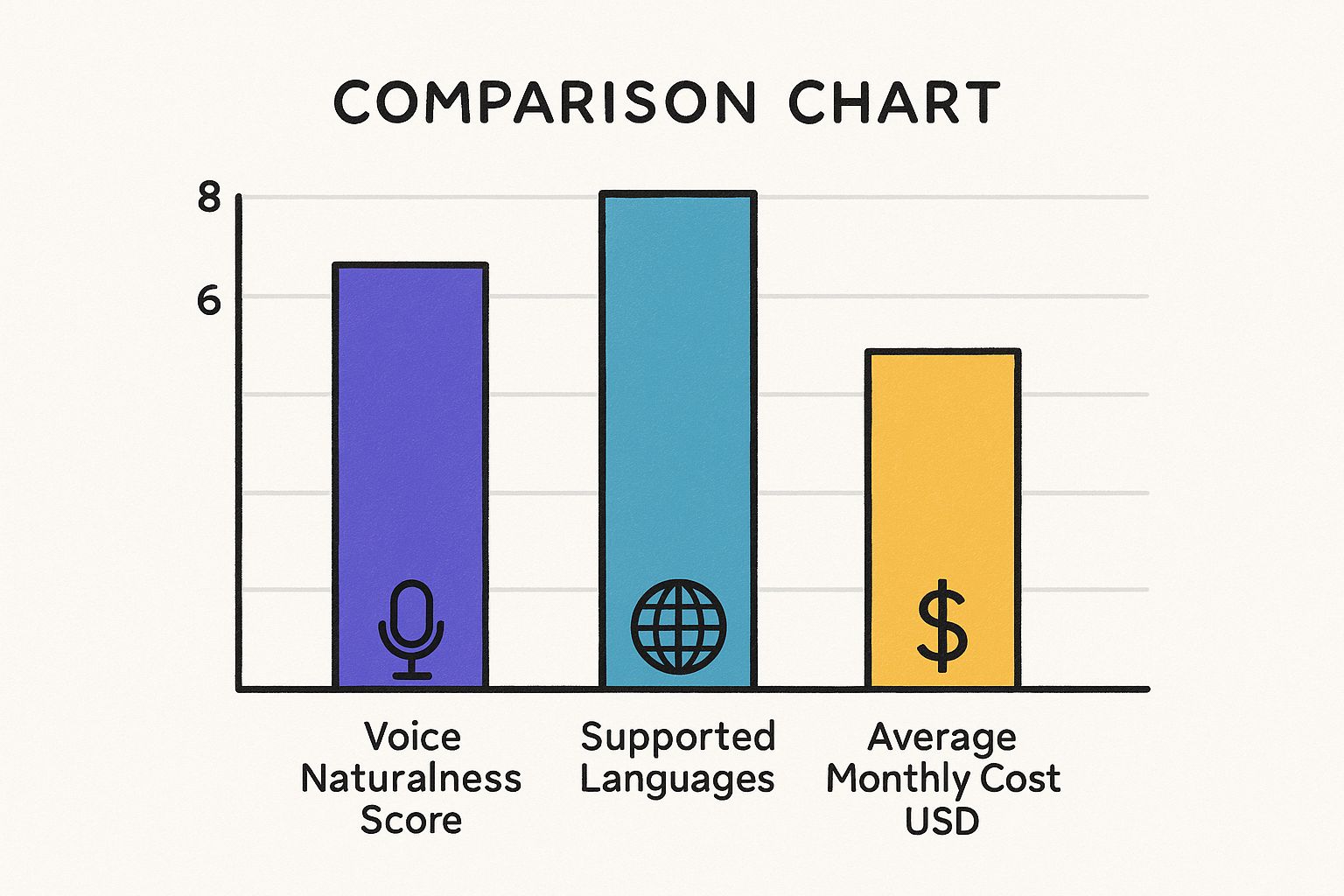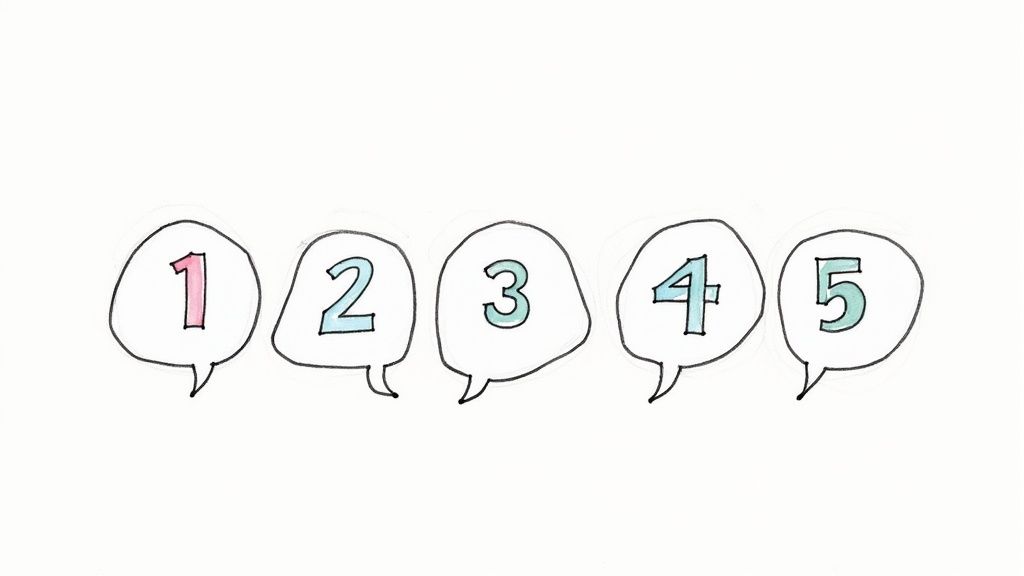Explore Top Text to Speech Software for Audio Conversion

Ever wished you had someone who could just read any article, document, or webpage out loud to you? That's the simple, powerful idea behind text to speech software. It’s about more than just hearing words; it’s about making information flexible enough to fit into our busy lives and creating content that stands out.
What Is Text to Speech Software Really
At its most basic, text to speech software is a type of tech that turns written digital words into spoken audio. Think of it as a translator, converting the text on your screen into something you can listen to anywhere. This whole process is often called speech synthesis, and it has come a long way from the clunky, robotic voices we used to hear.
Today's tools use sophisticated AI to do a lot more than just read. They analyze text, figure out the context, and generate voices that are stunningly human-like. They know how to pause for a comma, raise their intonation for a question, and can even inject emotion into their delivery. This massive jump in quality is why TTS is popping up everywhere. You can dive deeper into the nuts and bolts in our guide on how text to speech technology works.
The Evolution from Robotic to Realistic
The journey of TTS technology has been a sprint. Not too long ago, the voices were mechanical and hard to listen to for more than a few seconds. Now, the best platforms are nearly indistinguishable from a human voice actor. It’s like the difference between an early video game sprite and a modern, photorealistic character.
This diagram gives a peek behind the curtain, showing the main steps from text to audible sound wave.

It all starts with breaking down the text (pre-processing) and ends with the actual audio you hear, highlighting just how much goes into creating a single, natural-sounding word.
Why This Technology Is Gaining Momentum
The demand for high-quality TTS is absolutely exploding, and the market numbers back it up. The global Text-to-Speech software market was valued at around USD 3.19 billion in 2024 and is expected to hit USD 12.4 billion by 2033. This isn't just a niche trend; it's a reflection of how we want to consume content now—on the go, while multitasking, and through audio.
Platforms like Verbatik are riding this wave by giving creators and businesses the tools they need. A few key features are really pushing this forward:
- Unlimited Text to Speech: The freedom to convert huge volumes of text into audio without hitting a character limit is a game-changer for big projects like audiobooks or e-learning courses. Verbatik offers this, removing creative roadblocks.
- Voice Cloning: Imagine creating a completely unique digital voice from just a small audio sample. This allows brands to have a consistent, recognizable voice across all their audio content, and with Verbatik, you can do this an unlimited number of times.
- Accessibility and Multitasking: This technology opens up content to people with visual impairments or reading challenges. For everyone else, it’s the freedom to listen to an article during a commute or a report while at the gym.
Actionable Insight: Your audience is multitasking. Adding an audio version of your blog posts, reports, or articles using text to speech software is a strategic move to make your content more accessible and engaging, meeting your audience where they are.
How AI Is Teaching Computers to Speak

The leap from those clunky, robotic computer voices to the incredibly human-like narration we hear today didn't just happen. The secret sauce is Artificial Intelligence (AI), and it has completely flipped the script on how computers learn to talk.
Old-school text-to-speech was a brute-force effort. Programmers tried to manually write a rule for every single sound, pronunciation, and pause. It was as tedious and unnatural as it sounds. Modern AI takes a completely different road. Instead of following a rigid rulebook, these systems are trained on huge libraries of real human speech.
Think of it less like building a machine and more like coaching an actor. The AI listens to thousands of hours of audio, absorbing all the tiny details that make a voice sound real—the cadence, the emotion, the natural rhythm.
From Rules to Neural Networks
This smarter approach is powered by deep neural networks, complex systems designed to mimic the way a human brain learns. These networks can spot patterns in speech that are far too subtle for a person to ever write down as a rule. This is what allows them to generate audio that isn't just correct but actually compelling.
This tech is catching on fast. The Text-to-Speech market was already valued at USD 4.0 billion in 2024 and is on track to hit USD 7.6 billion by 2029. A lot of that growth is coming from places you might not expect, like in-car voice assistants that help drivers keep their eyes on the road.
This shift to AI-driven audio has put professional-grade voiceovers within reach for just about everyone. To see how this plays out in the real world, check out our guide on using text to speech with AI.
The Power of Voice Cloning
One of the most mind-blowing developments to come out of AI-powered TTS is voice cloning. This tech lets you create a digital copy of a specific person's voice from just a small audio clip. It's the ultimate form of personalization, moving way beyond picking a stock voice from a list.
For any creator or brand, this is a massive win. Instead of booking a voice actor for every single new video or ad, you can generate perfectly consistent, on-brand audio in an instant. Suddenly, you can have a signature voice for your YouTube channel, podcast, or company training videos.
Actionable Insight: Use voice cloning to build a recognizable audio brand. A consistent voice builds familiarity and trust, making your content stand out. With platforms like Verbatik offering unlimited voice cloning, you can create a unique audio identity without the high cost of traditional voiceover work.
Platforms like Verbatik have made this powerful technology incredibly easy to use. Better yet, they offer unlimited voice cloning, tearing down the cost barriers that used to reserve custom voices for huge companies with deep pockets. Now, any creator can craft their own unique sound.
Actionable Takeaways for Creators
Getting a handle on the AI behind these tools is key. Modern platforms now offer sophisticated AI voiceover features that give you incredible control over the final product. For anyone making audio content, leaning into these AI tools offers some clear advantages:
- Authenticity: AI models trained on real human speech deliver narration that captures genuine nuance and emotion, making your content way more engaging.
- Consistency: With voice cloning, your brand sounds the same everywhere—from social media clips to full-blown e-learning courses.
- Scalability: Thanks to unlimited text to speech, a feature central to platforms like Verbatik, you can take on huge projects like audiobooks or an entire podcast season without hitting a paywall or character limit.
This is what makes modern text to speech software so powerful. It’s no longer just a utility; it’s a core tool for creativity and growth.
What Makes a Great Text to Speech Tool?
Choosing the right text to speech software is a bit like shopping for a microphone. A cheap one might capture sound, but a professional one captures performance—the nuance, the emotion, and the clarity that makes people actually want to listen. It's the same with TTS. You need to look past the basic function of turning words into audio and focus on the features that give you a professional-grade final product.
The first thing to check is the quality and variety of the voices themselves. Any decent tool will have a library, but a powerful one gives you hundreds of voices that sound genuinely human, not like a GPS giving directions. Look for a wide range of languages, accents, and emotional tones to ensure you can find the perfect match for your brand and your audience.
But a huge voice library is just the starting point. The real magic happens when you can direct that voice.
Fine-Tuning and Creative Control
This is what separates the toys from the tools. A basic reader might let you speed things up or slow them down, but a professional platform puts you in the director's chair. You should be able to tweak the pitch, inject pauses for emphasis, and shift the emotional tone of the delivery.
Think about it. A slight pause right before you reveal a key statistic in a presentation can make all the difference. Adjusting the pitch can change a statement into a question. These aren't just bells and whistles; they're the controls you need to craft an audio experience that feels polished, intentional, and engaging.
Actionable Insight: To create compelling audio, choose a tool that lets you direct the voice. Experiment with adjusting pitch, rate, and adding pauses to emphasize key points. This transforms a simple reading into a memorable performance that connects with listeners.
This chart breaks down what you should be looking for, comparing different TTS options based on voice quality, language support, and overall capabilities.

As you can see, investing in tools with high voice naturalness and extensive language options gives you the most creative flexibility and the best long-term value.
To help you sift through the options, we've put together a quick comparison of the must-have features in any modern text to speech tool.
Evaluating Modern Text to Speech Software
Use this table to weigh what matters most for your projects, whether you're creating a quick voiceover or developing a full-scale audio brand.
| Feature | What to Look For | Why It Matters for Your Projects |
|---|---|---|
| Voice Quality & Variety | Hundreds of natural, human-like voices across many languages and accents. | Lets you find the perfect voice to match your brand's tone and connect with a global audience. |
| Customization Controls | The ability to adjust pitch, speed, volume, and add strategic pauses. | Gives you the creative power to direct the vocal performance, making audio more engaging and professional. |
| Usage Limits | High character counts or, ideally, an unlimited plan. | Removes creative roadblocks, allowing you to produce long-form content like audiobooks or podcasts without worry. |
| AI Voice Cloning | The option to create a digital replica of a specific voice from a short audio sample. | Essential for building a unique and consistent audio brand across all your content, from ads to tutorials. |
| API Access | A well-documented API for integrating TTS into your own applications. | Allows you to build custom workflows and embed high-quality voice generation directly into your products or services. |
Focusing on these core areas will ensure you pick a platform that can grow with your ambitions instead of holding you back.
Go Big with Unlimited Generation
If you're a serious content creator—producing podcasts, audiobooks, or a whole library of e-learning courses—character limits are your worst enemy. Hitting a monthly cap right in the middle of a big project is incredibly frustrating. This is why unlimited text to speech is a game-changer.
Platforms like Verbatik that offer an unlimited model are built for creators who think big. You can experiment, iterate, and produce as much audio as your schedule allows without ever worrying about usage meters or surprise fees. It means the tool works for you, not the other way around.
Own Your Sound with Voice Cloning
Having access to a great library of voices is one thing. Having your own unique voice is another. AI voice cloning makes this possible. With just a few minutes of recorded audio, you can create a perfect digital replica of your own voice or that of a voice actor you've hired.
This is huge for brand consistency. Imagine every single one of your YouTube videos, social media ads, and training modules featuring the same, familiar voice. It builds recognition and trust. For a more technical breakdown, check out our guide on exploring Verbatik TTS API features and benefits.
Better yet, Verbatik provides unlimited voice cloning, putting this incredibly powerful technology into the hands of any creator. You can develop a signature audio identity without the traditional costs and headaches of booking studio time for every new script. These features—lifelike voices, deep control, and unlimited creation—are what define truly powerful text to speech software today.
Practical Ways to Use Text to Speech
Knowing the features of text to speech software is one thing, but actually seeing it work wonders on your projects is something else entirely. The true magic happens when you stop thinking about the theory and start using it for real-world tasks. It's all about making better content, doing it faster, and connecting with people in ways you couldn't before.
For content creators, the benefits are huge and immediate. Picture this: you need a slick voiceover for your new YouTube documentary, but you don't have the time or budget for a recording studio. With the right TTS tool, you can turn a simple script into a professional-sounding narration in minutes, nailing the perfect tone and timing.
This is more than just a shortcut; it opens up new creative doors. You can play around with different voices, tweak scripts on the fly, and pump out high-quality audio at a pace that would be unthinkable with old-school methods.
Supercharge Your Content Creation Workflow
If you're making audio or video content regularly, your workflow is your lifeline. Think of high-quality text to speech software as a secret weapon—it automates the tedious parts of audio production so you can get back to the fun, creative stuff.
Here are actionable ways to integrate TTS into your workflow:
- Podcasting: Generate an entire episode from a script. For narrative shows, this ensures a consistent voice. For interview shows, use it for intros, outros, and ad reads.
- YouTube Voiceovers: Create clear, crisp narration for tutorials, documentaries, or listicles. Use voice cloning to develop a signature voice for your channel that becomes instantly recognizable.
- E-Learning Modules: Add an audio track to every lesson to improve information retention. Learners who see and hear content simultaneously are more likely to remember it.
The biggest win here is the ability to scale up. A platform like Verbatik, offering unlimited text to speech, throws the gates wide open. You can produce an entire audiobook or a full podcast season without ever hitting a character limit or watching costs pile up. This freedom lets you dream bigger and tackle ambitious projects that used to be out of reach.
Elevate Your Business and Marketing Efforts
It's not just for individual creators. Businesses are discovering some seriously clever ways to use TTS to make customers happier, launch more effective marketing, and just make things run smoother internally. The applications are everywhere, and they get real results.
One of the most obvious places is in customer communication. A polished, human-sounding voice for your automated phone system (IVR) makes a much better first impression than a choppy, robotic one. That small detail can make a huge difference in keeping customers happy and protecting your brand's image.
Marketing teams can also create amazing audio for their campaigns without the hassle and cost of hiring voice actors for every little thing. This is where AI tools really come into their own. If you're focused on using TTS for your ads and promos, you should explore a comprehensive list of top AI voiceover tools for marketing videos.
Actionable Insight: Use voice cloning to establish a consistent brand voice. Imagine the same friendly voice greeting customers on your support line, narrating your product demos, and speaking in your social media ads. That's how you build a powerful, memorable audio identity. With Verbatik's unlimited voice cloning, this is not just possible, but easy to scale.
Build a Unique Audio Brand with Voice Cloning
One of the coolest features in modern text to speech software is voice cloning. This tech lets you create a digital copy of a real voice from just a short audio sample. It's the ultimate way to move past generic stock voices and craft an audio brand that is 100% you.
For a company, this could mean cloning the CEO's voice for important internal messages or creating a custom brand personality for all public-facing content. For a creator, it means your digital self can keep narrating content even when you can't, keeping everything perfectly consistent.
This is another area where going unlimited is a game-changer. Verbatik provides unlimited voice cloning, giving you the power to create and deploy as many custom voices as you need. You can design different voices for characters in a story, produce localized ad campaigns with native accents, or just have a perfect digital version of your own voice on standby.
To get a better idea of what’s possible, check out these inspiring text to speech use cases and see how others are putting this technology to work right now.
How to Choose the Right TTS Software

Jumping into the world of text to speech software can feel a bit like walking into a massive electronics store. You're surrounded by countless options, all flashing their features, and it’s easy to get overwhelmed. The trick is to walk in with a clear list of what actually matters for your specific needs, whether you're a podcaster, an e-learning developer, or a business owner.
Making the right choice isn't about grabbing the tool with the longest feature list. It's about finding the one that truly fits your goals, your workflow, and your budget—and can keep up as you grow. Let's break down the essential things to look for.
Evaluate Voice Quality and Realism
The first and most important test is simple: close your eyes and just listen. Does the voice sound like a real person talking, or does it have that dead giveaway robotic drone? High-quality, natural-sounding voices are the absolute baseline for creating content that people will actually want to listen to.
Look for platforms that offer a deep bench of AI-powered voices. Having a wide selection of languages, regional accents, and even different emotional tones gives you the flexibility to perfectly match the audio to your audience. The voice you'd pick for a corporate training video is going to be wildly different from the one you need for a guided meditation app, right?
Prioritize Customization and Control
A great voice is only half the picture. The other half is being able to direct that voice. The best text to speech software puts you in the director's chair, giving you fine-tuned control over the final audio.
Before you pull the trigger on any tool, make sure it has these key customization features:
- Rate and Pitch Adjustment: Being able to speed up, slow down, raise, or lower the pitch is fundamental. This lets you match the narration's energy to your content's pacing.
- Strategic Pauses: Sometimes, silence speaks volumes. Adding brief pauses is critical for dramatic effect, emphasizing a key takeaway, and making the speech feel more human.
- SSML Support: For those who want to get really granular, Speech Synthesis Markup Language (SSML) support is a must. It lets you programmatically control pronunciation, volume, and emotional inflections with precision.
Actionable Insight: The goal is to find a tool that lets you craft an audio experience, not just generate a file. That level of control is what separates a decent voiceover from a truly professional and compelling one. Test these features during a free trial to see if the software gives you the creative power you need.
Understand the Pricing Models
This is where things can get confusing. Most TTS tools use one of two models: pay-per-character or a flat subscription. For a tiny, one-off project, a pay-per-character plan might look cheap, but those costs can get out of hand fast for anyone creating content regularly.
Think about producing an entire audiobook or a multi-module e-learning course. On a character-based plan, every single letter, space, and comma is literally costing you money. It's a model that punishes creativity and large-scale production.
That’s why a subscription that offers unlimited text to speech is such a game-changer. Platforms like Verbatik are built on this idea, giving you a fixed, predictable cost so you can create without hesitation. You can generate scripts, revise them ten times, and produce hours of audio without ever watching a meter run. For any serious creator or business, an unlimited plan is the only option that makes sense for growth.
The Power of Unlimited Voice Cloning
Finally, think about the future of your audio brand. While having a library of great stock voices is useful, what’s even better is having a unique, consistent voice that is instantly recognizable as yours. This is where AI voice cloning comes into play.
Look for a platform that not only has this feature but makes it truly accessible. Verbatik's unlimited voice cloning allows you to create a perfect digital replica of your own voice (or a voice actor's), cementing a unique audio identity across all your content. It turns your TTS software from a simple utility into a powerful branding machine, ensuring your projects always sound distinctively you.
Your Next Steps in Audio Content Creation
So, there you have it—a complete look at the world of text to speech software. We've covered the AI that makes it all possible, the must-have features, and how it's being used in the real world. The path to creating amazing audio is clearer and more open than ever before.
Forget the old days of needing expensive mics, studio time, and pricey voice actors. Those barriers are coming down fast. Modern TTS tools have completely changed the game, putting the power of a professional recording studio right on your desktop. This is your cue to stop thinking about it and start doing it.
Embrace Your Creative Freedom
There's no reason your audio creation journey can't start today. The trick is finding a tool that works with you, not against you. That's why platforms offering unlimited text to speech are so valuable—they let you experiment, tweak, and produce as much as you want without constantly checking a character counter or worrying about costs.
When you throw unlimited voice cloning into the equation, you suddenly have the power to create a sound that is uniquely yours. Platforms like Verbatik were built for exactly this, giving you all the tools you need to bring your ideas to life without cutting corners.
Actionable Insight: Your first step is to experiment. Take a short piece of your existing content—like a blog post intro or a social media update—and convert it to audio. Play with different voices and settings to see how it transforms the message. This hands-on test is the best way to understand the tool's potential.
As you get going, remember that the little details can elevate your work from good to great. To help you nail the sound from day one, check out these 10 essential voiceover tips for creating professional-quality audio. Now, it's time to dive in and see what you can create.
Your Top TTS Questions, Answered
Jumping into the world of text to speech software can bring up a few questions. Let's clear things up and give you the straightforward answers you need to get started.
What Is the Most Realistic Text to Speech Software?
The most lifelike voices aren't just pleasant to listen to; they're powered by sophisticated AI that understands the natural cadence and emotion of human speech. True realism comes from the ability to fine-tune the output—adjusting the pitch, speed, and even the pauses to perfectly match the feeling you're going for.
Platforms that offer AI voice cloning, like Verbatik, push this even further. By creating a digital copy of a real person's voice, the technology produces audio that's practically identical to a live speaker, giving you the most authentic narration possible. And with Verbatik's unlimited voice cloning, you can create as many unique, realistic voices as you need.
Can I Use Text to Speech for Commercial Projects?
Yes, definitely! The key is making sure you have the right license. Professional TTS platforms provide commercial licenses that give you the legal green light to use the AI-generated audio in any monetized content.
This covers projects like:
- YouTube videos that earn ad revenue
- Paid social media ads
- Online courses or corporate training videos
- Podcasts with sponsorships
This is exactly why a plan with unlimited text to speech is a game-changer for creators. With a service like Verbatik, you can produce endless commercial content without hitting character limits or paying extra, making it a breeze to scale up your projects.
Actionable Insight: Before you publish, always confirm that your TTS plan includes a commercial license. A trusted provider like Verbatik makes this clear, giving you peace of mind to monetize your audio content legally and without worry.
How Does Voice Cloning Work and Is It Difficult?
Voice cloning sounds complex, but it's really a smart AI process that just listens to a short audio sample of someone speaking. It picks up on all the unique details—the tone, the accent, the rhythm—and builds a digital model that can then say anything you type in that same exact voice.
Modern tools have made this incredibly simple. All you usually need to do is upload a few minutes of crisp, clear audio with no background noise, and the software handles the rest. Once the clone is ready, you can use it just like any other standard voice in the library. It’s no longer a tool just for massive companies; anyone can create a unique audio brand. Plus, Verbatik offers unlimited voice cloning, so you can create a distinct and consistent voice for every project you can imagine.
Ready to turn your text into audio that truly connects? Verbatik gives you unlimited text to speech, instant voice cloning, and a whole suite of AI tools to make content creation easy. Start creating professional-grade voiceovers today.
